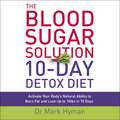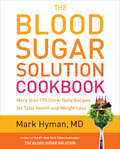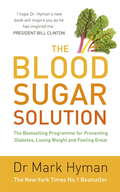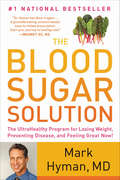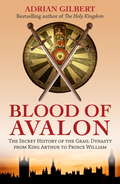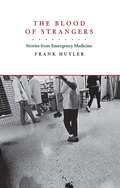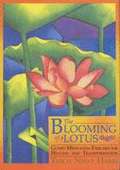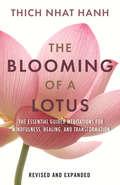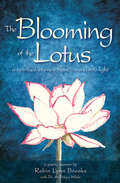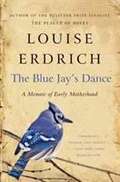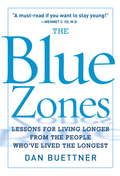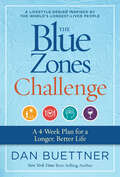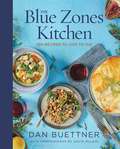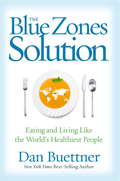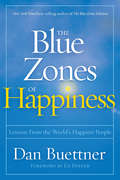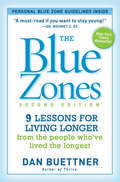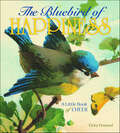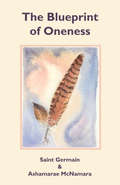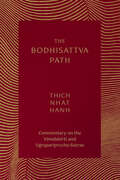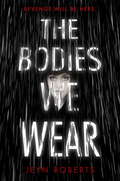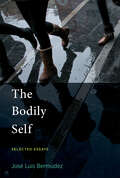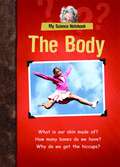- Table View
- List View
The Blood Sugar Solution 10-Day Detox Diet: Activate Your Body's Natural Ability to Burn fat and Lose Up to 10lbs in 10 Days
by Mark HymanDr. Hyman's revolutionary weight-loss programme, based on the #1 New York Times bestseller The Blood Sugar Solution, supercharged for immediate results.The key to losing weight and keeping it off is maintaining low insulin levels. Based on Dr. Hyman's groundbreaking Blood Sugar Solution program, The Blood Sugar Solution 10-Day Detox Diet presents strategies for reducing insulin levels and producing fast and sustained weight loss. You can lose up to 10lbs in 10 days!In The Blood Sugar Solution 10-Day Detox Diet Dr. Hyman explains how to: · activate your natural ability to burn fat - especially stubborn belly fat· reduce inflammation· reprogramme your metabolism· shut off your fat-storing genes· de-bug your digestive system· create effortless appetite control· and soothe the stress to shed the pounds.With convenient and practical tools such as meal plans, recipes, and shopping lists, as well as step-by-step, easy-to-follow advice on green living, supplements, medication, exercise, and more, The Blood Sugar Solution 10-Day Detox Diet is the fastest way to lose weight, prevent disease, and feel your best.(P)2014 Hachette Audio
The Blood Sugar Solution Cookbook: More than 175 Ultra-Tasty Recipes for Total Health and Weight Loss
by Mark HymanIn THE BLOOD SUGAR SOLUTION COOKBOOK, Dr. Mark Hyman shares recipes that support the BLOOD SUGAR SOLUTION lifestyle. In 1900, only two percent of meals in America were eaten outside the home; now it is over fifty percent. Dr. Hyman calls for readers to take back their health by taking back their kitchens. The major culprit of diabetes, obesity and heart disease is insulin imbalance. Following Dr. Hyman's scientifically based program for rebalancing insulin and blood sugar levels, this cookbook presents 175 delectable recipes that are free of allergens and harmful inflammatory ingredients. Readers will exchange toxic factory-made foods for nutritious and easy-to-make dishes such as Chicken Satay with Peanut Sauce, Mexican Shrimp Ceviche, Tuscan Zucchini Soup, Raspberry Banana Cream Pie Smoothie, Chocolate Nut Cake, and more. THE BLOOD SUGAR SOLUTION COOKBOOK will illuminate the inner nutritionist and chef in every reader.
The Blood Sugar Solution: The Bestselling Programme for Preventing Diabetes, Losing Weight and Feeling Great
by Mark HymanThe No.1 New York Times bestselling programme to fight diabetes, lose weight, and stay healthy.By 2025 there will be more than 4 million people in Britain with diabetes. Every day, 400 new cases are diagnosed. In The Blood Sugar Solution, Dr Mark Hyman reveals that the secret solution to losing weight and preventing diabetes - as well as heart disease, stroke, dementia, and cancer - is balanced insulin levels. The Blood Sugar Solution, Dr. Hyman gives us the tools to achieve this with his revolutionary six-week healthy-living programme and the seven keys to achieving wellness - nutrition, hormones, inflammation, digestion, detoxification, energy metabolism, and a calm mind. With advice on diet, exercise, supplements and medication, and options to personalise the plan for optimal results, The Blood Sugar Solution teaches readers how to maintain lifelong health. Groundbreaking and timely, The Blood Sugar Solution is the fastest way to lose weight, prevent disease, and feel better than ever.
The Blood Sugar Solution: The UltraHealthy Program for Losing Weight, Preventing Disease, and Feeling Great Now!
by Mark HymanThe #1 bestseller that offers "a ground breaking, science-based, easy-to-follow prescription. Start your journey to healing now!" - Mehmet Oz, MDDr. Mark Hyman reveals that the secret to losing weight and preventing not just diabetes but also heart disease, stroke, dementia, and cancer is balanced insulin levels. Dr. Hyman describes the seven keys to achieving wellness-nutrition, hormones, inflammation, digestion, detoxification, energy metabolism, and a calm mind-and explains his revolutionary six-week healthy-living program. With advice on diet, green living, supplements and medication, exercise, and personalizing the plan for optimal results, this book also teaches readers how to maintain lifelong health. Groundbreaking and timely, THE BLOOD SUGAR SOLUTION is the fastest way to lose weight, prevent disease, and feel better than ever.
The Blood of Avalon: The Secret History of the Grail Dynasty from King Arthur to Prince William
by Adrian GilbertThe story of King Arthur and the quest for the Holy Grail is well known; less so is that of the coming of Christianity to Britain at around the time of the Roman invasion. It is generally assumed that both these legends revolve around town of Glastonbury, yet the paucity of evidence for this assumption has always been troubling to those who like their history to be founded on fact. In this extraordinary book, Adrian Gilbert reveals the location to be not just of the true 'Avalon' or 'Glastonbury' but of many other sites crucial to the Arthurian legend. He shows how the core teachings of Christianity were kept secret by a dynasty of Welsh kings and saints and later (after the Norman invasions) by their surviving descendants. For centuries this remnant of the Brittano-Welsh nobility, still living in 'Avalon', kept alive a hope: they prayed that one day a new Arthur, one with the holy blood of the family of Mary flowing in his veins, would sit once more on the throne of Britain. Extraordinary as it may seem, this hope may soon be realised - for through the late Diana, Princess of Wales, our own Prince William, whose middle name is indeed Arthur, is so descended.
The Blood of Strangers: Stories from Emergency Medicine
by Frank HuylerReminiscent of Chekhov's stories, The Blood of Strangers is a visceral portrayal of a physician's encounters with the highly charged world of an emergency room. In this collection of spare and elegant stories, Dr. Frank Huyler reveals a side of medicine where small moments--the intricacy of suturing a facial wound, the bath a patient receives from her husband and daughter--interweave with the lives and deaths of the desperately sick and injured. The author presents an array of fascinating characters, both patients and doctors--a neurosurgeon who practices witchcraft, a trauma surgeon who unexpectedly commits suicide, a wounded murderer, a man chased across the New Mexico desert by a heat-seeking missile. At times surreal, at times lyrical, at times brutal and terrifying, The Blood of Strangers is a literary work that emerges from one of the most dramatic specialties of modern medicine. This deeply affecting first book has been described by one early reader as "the best doctor collection I have seen since William Carlos Williams's The Doctor Stories."
The Blooming of a Lotus
by Thich Nhat HanhCompanion volume to the best-selling The Miracle of Mindfulness One of the world’s great meditation teachers offers guided exercises that will bring both beginning and experienced practitioners into closer touch with their bodies, their inner selves, their families, and the world. In this revised edition of the classic text, five new meditations show readers how mindful consumption and mindful actions can help prevent suffering and water the seeds of compassion; how to be in touch with our Buddha selves; and how to deepen our relationships with our parents. Compassionate and wise, Thich Nhat Hanh’s healing words help us acknowledge and dissolve anger and separation by illuminating the way toward the miracle of mindfulness.
The Blooming of a Lotus REVISED & EXPANDED: Essential Guided Meditations for Mindfulness, Healing, and Transformation
by Thich Nhat HanhOne of the world's great meditation teachers offers thirty-four guided exercises that will bring both beginning and experienced practitioners into closer touch with their bodies, their inner selves, their families, and the world. Compassionate and wise, Thich Nhat Hanh's healing words help us acknowledge and dissolve anger and separation by illuminating the way toward the miracle of mindfulness.
The Blooming of the Lotus: A Spiritual Journey From Trauma Into Light
by Robin Lynn BrooksSurvivors often feel alone in their experiences, with emotions that linger long after the trauma is over. As a survivor of incest, Robin Lynn Brooks understands the feelings. In her ground-breaking poetic memoir, The Blooming of the Lotus, she takes you on her deeply personal journey of healing. Traveling into the abyss of her past, exploring the depths of her experiences with brutal incest, violence, and torture, she journeys on her awe-inspiring quest to uncover her authentic self. The book will strike a cord with survivors, lending hope that even the deepest, darkest pit of despair can be opened to the light. "I have heard many accounts of trauma over the years, yet it is rare to come upon one captured so perfectly and expressed with such candor, beauty, and grace. . . Robin's inexhaustible courage, perseverance, and insight through the maze of self-discovery and healing are reflected on every page. She poignantly reveals her deepest vulnerability in an effort to share her story and healing process with other survivors. With great success she conveys that the journey from the darkest imprisonment to the light of freedom is indeed possible. This memoir is Robin's gift to us all." ~AnDréya Wilde, Ph.D.
The Blue Book: What You Want to Know about Yourself
by TarshiThe Blue Book is a booklet on sex education intended for 15-year-olds and older teens.
The Blue Jay's Dance: A Memoir Of Early Motherhood
by Louise ErdrichLouise Erdrich's first major work of nonfiction, The Blue Jay's Dance, brilliantly and poignantly examines the joys and frustrations, the compromises and the insights, and the difficult struggles and profound emotional satisfactions the acclaimed author experienced in the course of one twelve–month period—from a winter pregnancy through a spring and summer of new motherhood to her return to writing in the fall. In exquisitely lyrical prose, Erdrich illuminates afresh the large and small events that every parent will recognize and appreciate.
The Blue Zones
by Dan BuettnerWith the right lifestyle, experts say, chances are that you may live up to a decade longer. What's the prescription for success? National Geographic Explorer Dan Buettner has traveled the globe to uncover the best strategies for longevity found in the Blue Zones: places in the world where higher percentages of people enjoy remarkably long, full lives. And in this dynamic book he discloses the recipe, blending this unique lifestyle formula with the latest scientific findings to inspire easy, lasting change that may add years to your life.Buettner's colossal research effort, funded in part by the National Institute on Aging, has taken him from Costa Rica to Italy to Japan and beyond. In the societies he visits, it's no coincidence that the way people interact with each other, shed stress, nourish their bodies, and view their world yields more good years of life. You'll meet a 94-year-old farmer and self-confessed "ladies man" in Costa Rica, an 102-year-old grandmother in Okinawa, a 102-year-old Sardinian who hikes at least six miles a day, and others. By observing their lifestyles, Buettner's teams have identified critical everyday choices that correspond with the cutting edge of longevity research--and distilled them into a few simple but powerful habits that anyone can embrace.
The Blue Zones Challenge: A 4-Week Plan for a Longer, Better Life (Blue Zones)
by Dan BuettnerIn this companion to the number one New York Times bestseller The Blue Zones Kitchen, Dan Buettner offers a four-week guide and year-long sustainability program to jump-start your journey to better health, happiness, less stress, and a longer life. Get started on the path to a longer, healthier, happier life with this quick start to building your own Blue Zones lifestyle. Dan Buettner, founder of the Blue Zones and author of the New York Times number one best-selling Blue Zones Kitchen, offers the challenge of a lifetime: Build a foundation for better nutrition, more exercise, and a stronger social life that will extend your lifetime by years. In this easy-to-implement guide, you'll start with the rules of the Blue Zones Challenge, including tips and tricks from the five Blue Zones - locations around the world where people consistently live to 100--advice for setting up a successful kitchen and pantry, and resources for expanding you support network. Then, follow week-by-week prompts to: Change your dietIncrease your activityUpdate your living spacesBuild your social life. After four weeks--and with the help of easy-to-use worksheets and recipes - you'll see results in your weight, your well-being, and your general health. From there, follow the Blue Zones challenge through the rest of the year with an 11-month sustainability calendar that will continue to encourage you and build upon the foundation you've already started.What you'll find is living to 100 is easy - it just takes following the Blue Zones way!
The Blue Zones Kitchen: 100 Recipes to Live to 100 (The Blue Zones)
by Dan BuettnerBest-selling author Dan Buettner debuts his first cookbook, filled with 100 longevity recipes inspired by the Blue Zones locations around the world, where people live the longest.Building on decades of research, longevity expert Dan Buettner has gathered 100 recipes inspired by the Blue Zones, home to the healthiest and happiest communities in the world. Each dish--for example, Sardinian Herbed Lentil Minestrone; Costa Rican Hearts of Palm Ceviche; Cornmeal Waffles from Loma Linda, California; and Okinawan Sweet Potatoes--uses ingredients and cooking methods proven to increase longevity, wellness, and mental health. Complemented by mouthwatering photography, the recipes also include lifestyle tips (including the best times to eat dinner and proper portion sizes), all gleaned from countries as far away as Japan and as near as Blue Zones project cities in Texas. Innovative, easy to follow, and delicious, these healthy living recipes make the Blue Zones lifestyle even more attainable, thereby improving your health, extending your life, and filling your kitchen with happiness.
The Blue Zones Solution
by Dan BuettnerDan Buettner, the New York Times bestselling author of The Blue Zones, lays out a proven plan to maximize your health based on the practices of the world's healthiest people. For the first time, Buettner reveals how to transform your health using smart eating and lifestyle habits gleaned from new research on the diets, eating habits, and lifestyle practices of the communities he's identified as "Blue Zones"--those places with the world's longest-lived, and thus healthiest, people. With this book's audacious belief that the lifestyles of the world's Blue Zones could be adapted and replicated in towns across North America, you'll be inspired by the specific stories of the people, foods, and routines of our healthy elders; understand the role community, family, and naturally healthy habits can play to improve our diet and health; and learn the exact foods--including the 50 superfoods of longevity and dozens of recipes adapted for Western tastes and markets--that offer delicious ways to eat your way to optimum health. Filled with moving personal stories, delicious recipes, checklists, and useful tips that will transform any home into a miniature blue zone, The Blue Zones Solution is the ultimate blueprint for a healthy, happy life.
The Blue Zones Solution: Eating and Living Like the World's Healthiest People
by Dan BuettnerIn this groundbreaking book, Dan Buettner reveals how to transform your health using smart eating and lifestyle habits gleaned from new research on the diets, eating habits, and lifestyle practices of the communities he's identified as "Blue Zones", those places with the world's longest-lived, and thus healthiest, people, including locations such as Okinawa, Japan; Sardinia, Italy; Costa Rica's Nicoya Peninsula; Ikaria, Greece; and Loma Linda, California. With the audacious belief that the lifestyles of the world's Blue Zones could be adapted and replicated in towns across North America, Buettner launched the largest preventive health care project in the United States, The Blue Zones City Makeovers, which has impacted the health of millions of Americans since 2009. In The Blue Zones Solution, readers can be inspired by the specific stories of the people, foods, and routines of our healthy elders; understand the role community, family, and naturally healthy habits can play in improving our diet and health; and learn the exact foods, including the 50 superfoods of longevity and dozens of recipes adapted for Western tastes and markets, that offer delicious ways to eat your way to optimum health. Throughout the book are lifestyle recommendations, checklists, and stories to help you create your own personal Blue Zones solution. Readers will learn and apply the 80/20 rule, the plant slant diet, social aspects of eating that lead to weight loss and great health naturally, cultivating your "tribe" of friends and family, and your greater purpose as part of your daily routine. Filled with moving personal stories, delicious recipes, checklists, and useful tips that will transform any home into a miniature blue zone, The Blue Zones Solution is the ultimate blueprint for a healthy, happy life.
The Blue Zones of Happiness: Lessons From the World's Happiest People (The Blue Zones)
by Dan Buettner Ed DienerNew York Times best-selling author Dan Buettner reveals the surprising secrets of what makes the world's happiest places—and shows you how to apply these lessons to your own life. In this inspiring guide, you’ll find game-changing tools drawn from global research and expert insights for achieving maximum fulfillment. Along the way, you'll: • Discover the three strands of happiness—pleasure, purpose, and pride—that feature prominently in the world's happiest places. • Take the specially designed Blue Zones Happiness Test to pinpoint areas in your life where you could cultivate greater joy, deeper meaning, and increased satisfaction. • Meet the world's Happiness All-Stars: inspiring individuals from Denmark to the United States who reveal dynamic, practical ways to improve day-to-day living. • Discover specific, science-based strategies for setting up a “life radius” of community, work, home, and self to create healthier, happiness-boosting habits for the long-term.
The Blue Zones, Second Edition
by Dan BuettnerSince publishing his bestselling The Blue Zones, longevity expert and National Geographic Explorer Dan Buettner has discovered a new Blue Zone and launched a major public health initiative to transform cities based on principles from this book. The Blue Zones, Second Edition is completely updated and expands his bestselling classic on longevity, drawing on his research from extraordinarily long-lived communities--Blue Zones--around the globe to highlight the lifestyle, diet, outlook, and stress-coping practices that will add years to your life and life to your years.The new Blue Zone is Ikaria, Greece, where strong, sweet wine, family, and a Mediterranean diet all play a role in longer life. Also new in this book is a reading group guide, designed for groups to read about, discuss, and implement many of the simple changes advocated for better health.A long, healthy life is no accident. It begins with good genes, but it also depends on good habits. If you adopt the right lifestyle, experts say, chances are you may live up to a decade longer. Buettner has led teams of researchers across the globe--from Costa Rica to Sardinia, Italy, to Okinawa, Japan and beyond--to uncover the secrets of Blue Zones. He found that the recipe for longevity is deeply intertwined with community, lifestyle, and spirituality. People live longer and healthier by embracing a few simple but powerful habits, and by creating the right community around themselves. In The Blue Zones, Second Edition, Buettner has blended his lifestyle formula with the latest longevity research to inspire lasting, behavioral change and add years to your life.Region by region, Buettner reveals the "secrets" of longevity through stories of his travels and interviews with some of the most remarkable--and happily long-living people on the planet. It's not coincidence that the way they eat, interact with each other, shed stress, heal themselves, avoid disease, and view their world yield them more good years of life. Buettner's easy to follow "best practices" and list of healthy lifestyle choices from the Blue Zones will empower readers to live longer, healthier, more fulfilling lives.
The Blue Zones, Second Edition: 9 Lessons for Living Longer From the People Who've Lived the Longest
by Dan BuettnerSince publishing his bestselling The Blue Zones, longevity expert and National Geographic Explorer Dan Buettner has discovered a new Blue Zone and launched a major public health initiative to transform cities based on principles from this book. The Blue Zones, Second Edition is completely updated and expands his bestselling classic on longevity, drawing on his research from extraordinarily long-lived communities - Blue Zones - around the globe to highlight the lifestyle, diet, outlook, and stress-coping practices that will add years to your life and life to your years.The new Blue Zone is Ikaria, Greece, where strong, sweet wine, family, and a Mediterranean diet all play a role in longer life. Also new in this book is a reading group guide, designed for groups to read about, discuss, and implement many of the simple changes advocated for better health.A long, healthy life is no accident. It begins with good genes, but it also depends on good habits. If you adopt the right lifestyle, experts say, chances are you may live up to a decade longer. Buettner has led teams of researchers across the globe - from Costa Rica to Sardinia, Italy, to Okinawa, Japan and beyond - to uncover the secrets of Blue Zones. He found that the recipe for longevity is deeply intertwined with community, lifestyle, and spirituality. People live longer and healthier by embracing a few simple but powerful habits, and by creating the right community around themselves. In The Blue Zones, Second Edition, Buettner has blended his lifestyle formula with the latest longevity research to inspire lasting, behavioral change and add years to your life.Region by region, Buettner reveals the "secrets" of longevity through stories of his travels and interviews with some of the most remarkable - and happily long-living people on the planet. It's not coincidence that the way they eat, interact with each other, shed stress, heal themselves, avoid disease, and view their world yield them more good years of life. Buettner's easy to follow "best practices" and list of healthy lifestyle choices from the Blue Zones will empower readers to live longer, healthier, more fulfilling lives.
The Bluebird of Happiness: A Little Book of Cheer
by Vicky HowardThe bluebird has long been considered a symbol of happiness and a messenger of joy and contentment. . . . It is my hope that this book, like the bluebird's song of happiness, will bring cheer and joy to your life. —Vicky Howard, introduction* Vicky Howard's collection of antique bird art—nearly all pieces over 100 years old—is used here to adorn her lovely message about what is really important in our pursuit of happiness.Vicky Howard is a successful and recognizable name in the gift market.Using art from her private collection of vintage postcards, Howard presents avian images alongside positive-minded quotes from the early 1900s. While the creative elements of this book recall an early era, the art remains vivid and the words decidedly relevant:* You cannot always have happiness, but you can give happiness. —Proverb* The art of being happy lies in the power of extracting happiness from common things. —Henry Ward Beecher
The Blueprint of Oneness
by Saint Germain Ashmarae McnamaraInspiring and interactive, this manual demonstrates how to effortlessly release negative belief patterns and to respond positively to any situation by following the guidance of Ascended Master, Saint Germain. Providing the tools to connect to higher frequencies, this handbook encourages that individuals seeking spiritual enlightenment breathe, feel, and allow the energy of Saint Germain into their beings in order to realize his teachings. This remarkable meditation argues that integration and self-transformation can occur not only through the mind but also through the heart itself.
The Bodhisattva Path: Commentary on the Vimalakirti and Ugrapariprccha Sutras
by Thich Nhat HanhLearn about the bodhisattva ideal—the capacity to see the potential for awakening in everyone and aspire to help them along their path—with new commentaries on early Mahayana sutras from Zen Master Thich Nhat Hanh, the monk Time magazine calls "the father of mindfulness."Based on a three-month retreat given by Ven. Thich Nhat Hanh in the winter of 1991, this book gives an historical account of the emergence of the bodhisattva ideal during the first century CE, together with Thich Nhat Hanh's previously unpublished commentaries on two early Mahayana sutras—the Ugraparipṛccha Sutra (The Questions of the Householder Ugra) and the Vimalakīrti-nirdeśa Sutra (The Instructions of Vimalakīrti). About 150 years after the death of the historical Buddha, Buddhism had begun to develop into many separate schools, in which many monks came to prioritize their own personal liberation in their teaching and practice, while making Buddhism into a series of doctrines that served their own school. They came to live in a way that was cut off from other schools and from laypeople and saw laypeople as there primarily to make offerings and support the monks, not as practitioners who could also benefit fully from the Buddha&’s teachings. Consequently, around the first century CE, there arose among lay and monastic practitioners the desire to popularize Buddhism and bring it out of the ivory tower and back in touch with life in the world, as it had been in the time of the Buddha. From this movement sprang the Mahayana path, which aimed to provide the deepest wellsprings of Buddhist thought to all people, regardless of their social background. Central to the Mahayana teachings is the idea of bodhicitta (the mind of love), which was personified in the bodhisattva, who sees the potential for enlightenment in everyone and vows to help them on their path to awakening.Soon Mahayana sutras began to appear, encouraging practitioners to develop the qualities of a bodhisattva in themselves. The Ugraparipṛccha Sutra counsels students on the bodhisattva path, giving practical instructions on how to help others suffer less. The Vimalakīrti-nirdeśa Sutra focuses on bringing the deepest teachings of Buddhism to ordinary people, with teachings on the ultimate dimension and Buddhist ethics. With his insightful commentary on these two important sutras, Ven. Thich Nhat Hanh continues the inclusive spirit of the early Mahayana practitioners.
The Bodies We Wear
by Jeyn RobertsA streetwise girl trains to take on a gang of drug dealers and avenge her best friend's death in this thriller for fans of Scott Westerfeld and Robin Wasserman. Heam: It's the hottest drug around. Users are able to see Heaven--a place so beautiful, so indescribably serene, many people never want to come back. And some don't, like Faye's best friend, Christian. But when Faye was forced to take Heam, she didn't see Heaven; she saw Hell. And now she spends her nights training to take revenge on the men who destroyed her future and murdered Christian. When a mysterious young man named Chael appears, Faye's plans suddenly get a lot more complicated. Love and Death. Will Faye overcome her desires, or will her quest for revenge consume her?From the Hardcover edition.
The Bodily Self: Selected Essays (The\mit Press Ser.)
by Jose Luis BermudezEssays on the role of the body in self-consciousness, showing that full-fledged, linguistic self-consciousness is built on a rich foundation of primitive, nonconceptual self-consciousness.These essays explore how the rich and sophisticated forms of self-consciousness with which we are most familiar—as philosophers, psychologists, and as ordinary, reflective individuals—depend on a complex underpinning that has been largely invisible to students of the self and self-consciousness. José Luis Bermúdez, extending the insights of his groundbreaking 1998 book, The Paradox of Self-Consciousness, argues that full-fledged, linguistic self-consciousness is built on a rich foundation of primitive, nonconceptual self-consciousness, and that these more primitive forms of self-consciousness persist in ways that frame self-conscious thought. They extend throughout the animal kingdom, and some are present in newborn human infants. Bermúdez makes the case that these primitive forms of self-awareness can indeed be described as forms of self-consciousness, arguing that they share certain structural and epistemological features with full-fledged, linguistic self-consciousness. He offers accounts of certain important classes of states of nonconceptual content, including the self-specifying dimension of visual perception and the content of bodily awareness, considering how they represent the self. And he explores the general role of nonconceptual self-consciousness in our cognitive and affective lives, examining in several essays the relation between nonconceptual awareness of our bodies and what has been called our “sense of ownership” for our own bodies.
The Body (My Science Notebook)
by Martine PodestoAn exciting question-and-answer series to make key science concepts fun to learn. This book answers questions about our bodies.
